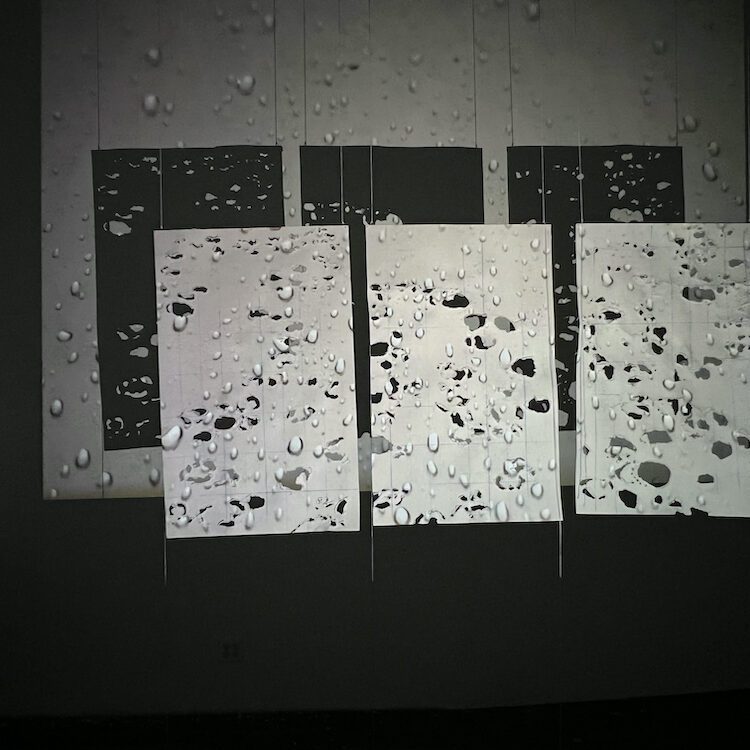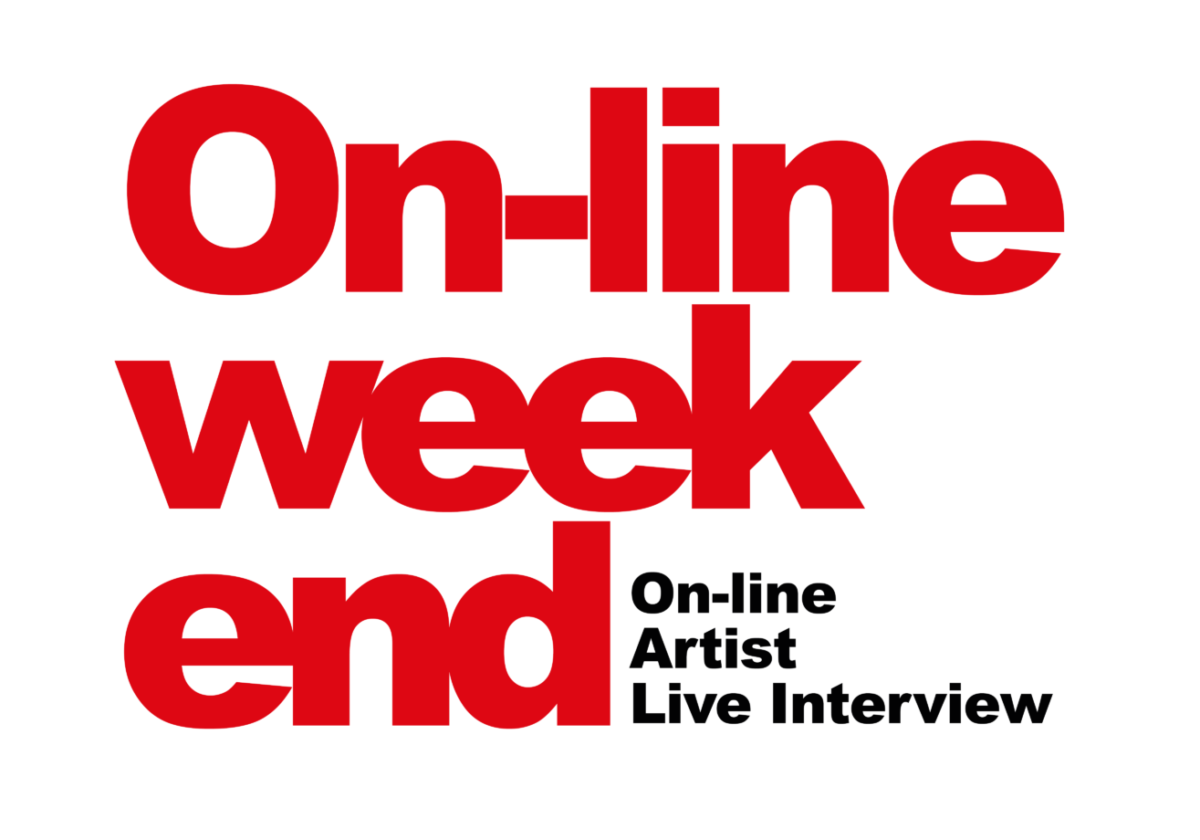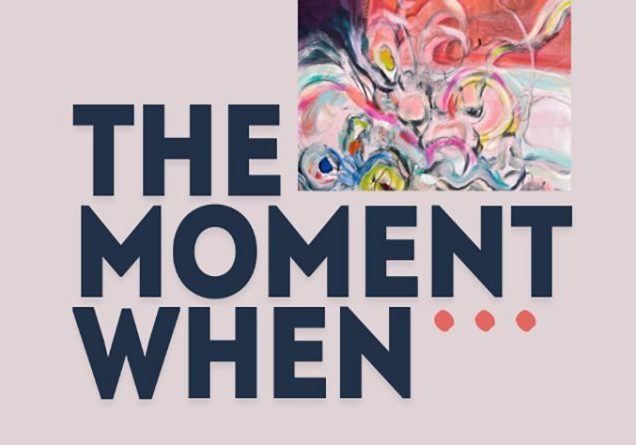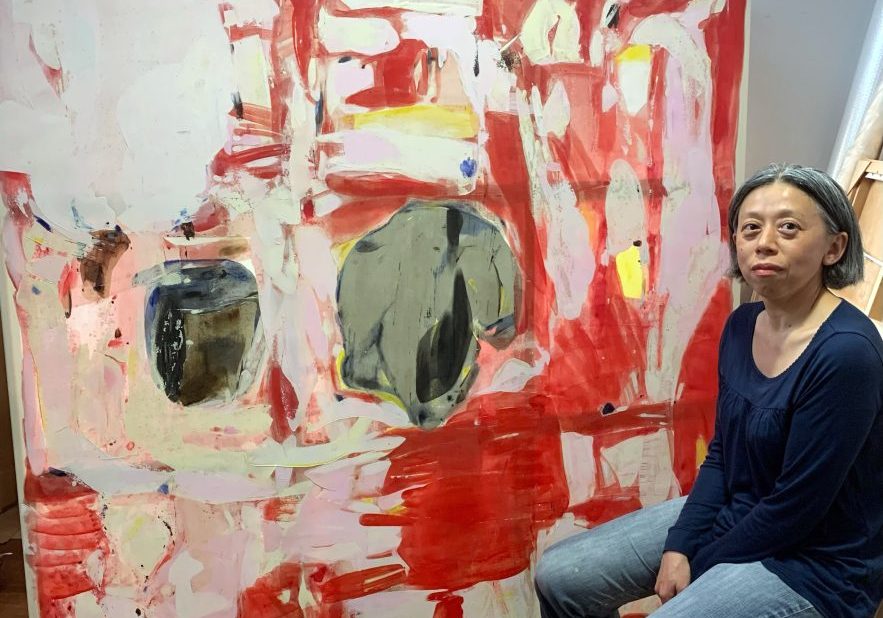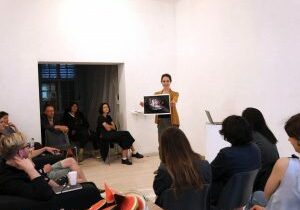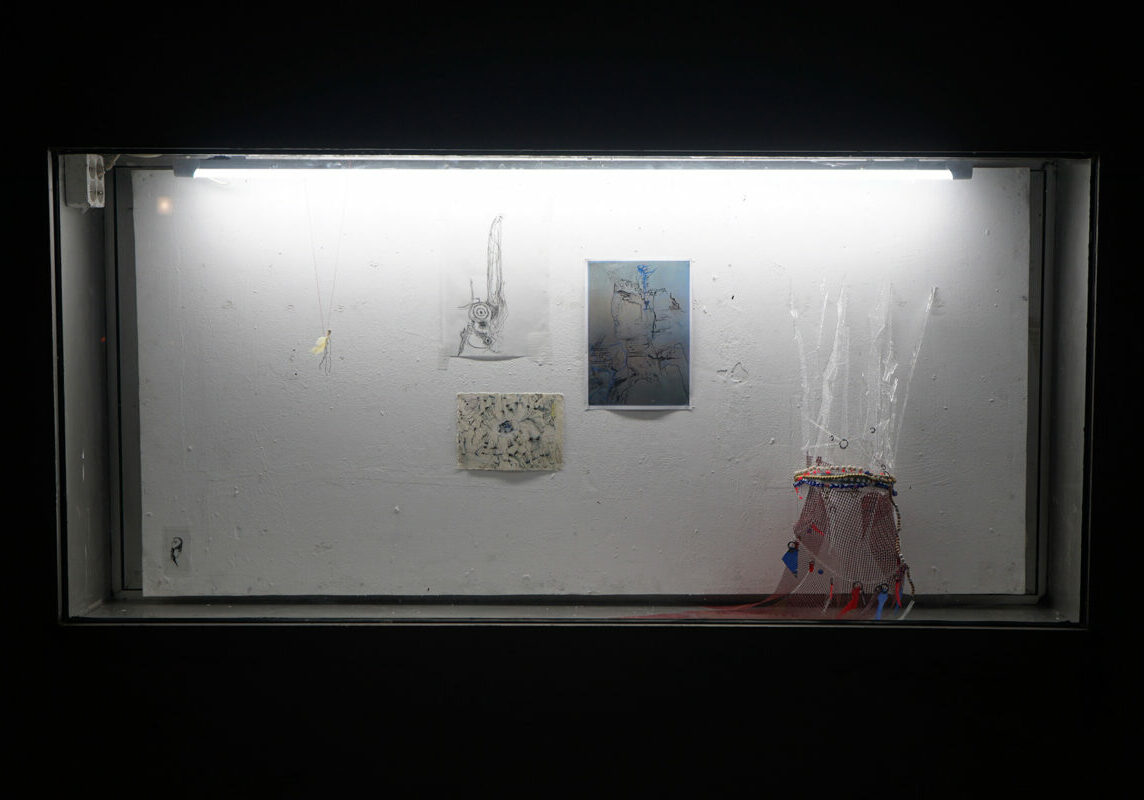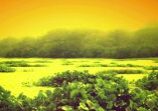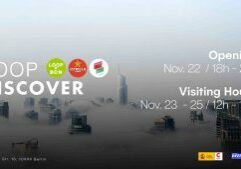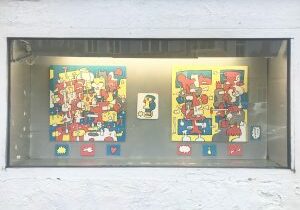Meet the Artist // Taryn Kneteman
I climbed the stairs to Taryn’s studio, situated on the GlogauAIR third floor. I was greeted by a mysterious tapping noise as water flowed through her world. I knocked and entered into her world of found objects, water, and mesmerizing reflections.
What brought you here to GlogauAIR?
Mainly friends. One artist I know, Annelies Kamen, did this residency. Yes. And then another friend from Edmonton. Gabrielle Paré moved here into a printmaking studio called Keystone Editions, when I came to visit her here in Berlin, I had a chance to experience printmaking as well.
So you have also done a printmaking course here in Berlin?
Yes, back in 2015. That was my first real experience of the city, but I was mostly learning new printing techniques. I wanted to come back, have a studio, be amongst other artists who are here to make projects.
How has Berlin nurtured your practice, if it has done in any way?
I think in the last year I’ve been consciously challenging myself to use more found objects. Things like furniture, old plates, cups, mainly domestic things. I’m kind of constructing a home. Like these light fixtures cover and the shelving of this car radiator. I want to combine things that are familiar when you look at the installations, yet also indented with this sense of subversion.
Do you want an element of familiarity?
Yes. Yeah, that’s then shifted by the videos.
Where did your idea for this piece come from?
I made a previous piece where I used suspended paper. My transition to installation was projecting onto the paper itself. Tearing holes and experimenting with the projected light.
Which you developed when you were printmaking
Yes. There’s so much care taken with the surface of the paper in printmaking, and so much care to make this flat surface really have such a depth. I was feeling a bit claustrophobic, I think, in my person. I thought maybe I wanted to try and use all the different planes of the paper.
Then the video work is a way to use different layers in space, I think. And I was starting to use the paper because often when we watch a movie at the cinema, you almost lose your body and you’re totally immersed in the film. And then the projection surface disappears. But I want to make the projection surface have this tactile quality that makes you really aware that it’s physical. And that we are physical too.
Yeah. And this strong interest in water. And like that kind of substance? How does that fit in?
I grew up doing a lot of swimming. And doing a lot of water skiing.I spent a lot of time at lakes with my family. A bit of a bit of time, also in the ocean growing up. And so there’s a strong familiarity.
You think it started in childhood?
Yeah. The childhood familiarity. I love the feeling of floating in water, feeling that release of gravity and weightlessness.
With Water skiing, you get to move so fast across the surface of the water in a way that’s not possible without the speed.. So it really feels almost like a flying kind of feeling.
Why do you like working with it as a medium?
I think because it connects the exterior world with the interior. Through eating and drinking. And to me, it feels like a material that kind of flows through us. And connects us with nature.
Yes, and babies are suspended in a sack of water.
There was this artist who made this whole piece about l humans being related to the sea.
Yes, they are mini oceans, the amniotic fluid.
I think the idea of water and weather is really interesting. We observe it so much in the world. I like thinking about weather as a metaphor for emotions and physiological changes, too.
you did all those really cool videos, jumping on and off the chair. What do you do with those?
Those are new. I have studied dance for a long time. Ballet, jazz, and some contemporary movements. And it was very choreographed. And so now with the jumping and the falling, I’m trying to record them, and then use video to make a choreography of movements that doesn’t really exist in the world but exists in the video. My thinking is that I like doing pieces with projection and shadows, maybe using some silhouettes of movement in a future version of the work.
Or movements that aren’t only in the video, maybe someone is walking in front of the projector. But then it’s, there’s actually no one there, leaving the question of what’s actually happening in the real moment. It is very airy in a way.
Because In a way you’re observing this person. But you don’t know who they are? you’re kind of looking into their life, but they’re a bit closed.
Yeah. I’m interested in the feeling that maybe you’re inside looking out, but you could also be outside looking, that kind of duality.
Did you just find that blind on the street?
Yeah Another way that Berlin has nurtured my practice is that there are all these interesting objects lying around. It kind of feels like objects in people’s homes spill out onto the street a bit. Also the basement here at GlogauAIR is filled with many interesting things. So I think, for me, the unexpected items found have been a good addition to my work. It disrupts my routine or my original plan.
So you kind of didn’t really have a plan?
I had a plan. Well, sort of had a plan.
Sounds and stuff have changed, but I had an initial idea.
I want to make more of a narrative video piece about water and about tears. About a person who gives up their tear ducts to an object so that they can’t cry, or don’t have to cry anymore. But then the object takes on the pain. So I think that I’m still gearing up to do that, but have made some sculptures that are maybe the objects that are doing that. Like the last one. The radio antenna fountain.
Yeah. Because when it’s turned on, it has that really eerie sound. Constantly dripping water, which can be quite off putting in a good sea, works well running in here. Because when you hear running water, I think even though it’s supposed to be something natural. I think now when we hear running water, we think there’s a problem.
Yes. And it can be. I think this sound is very important, it reminds us and connects us to the world around us. I find it often creates a sense of nostalgia, especially with all these droughts at the moment.
Has the change in water here, and all the canals and stuff, and the frequency of rain here changed your relationship with water, and water movement?
Certainly. At home, there’s a river that goes through the center of the city. One main river that’s quite wide and the valley Banks are very steep. There are branches across it. But biking, you have to go through this big incline. And there’s a river valley park that’s quite forested. So it’s beautiful.
Here, it’s different. There are so many different little rivers and canals. People sitting right at the water edge. Drinking Radler or drinking a beer, holding the bottle. So I feel like looking at the bottles in the light is also a big inspiration for me. How they reflect light. Also looking at the water through the bottles creates this wonderful array of reflections. It was a big inspiration for this piece too. All the glasses and bottles left on the canal edges as well. They show that someone was there.
Yeah, the piece sort of suggests that there’s someone there that you’ve never seen?
Yeah, Often I think about how a chair is an object like an empty chair. It suggests the absence of a person.
Like an empty coffee cup. I guess that feeling of a lost memory. Or like a past life?
I think also, we learned that Chema Alvargonzalez lived on this third floor. And so I’ve been experimenting with the marbles, and glass objects. Also looking at his works with the open suitcases that have one side with a mirror and one side with a light box image. Looking at a lot of reflections using different materials.
You use this heavy kind of imagery of tears? Do you find them quite heavy?
I think they can be really beautiful. But they can also be very, very loaded. There is also this question of what empathy is directly based on. I think it can be violent sometimes too.
At the same time, I’ve been thinking about tears as a bodily fluid, but I don’t think they have the same kind of density as other fluids. If you see sweat sweat or hair or like urine or blood, there’s this revulsion where. It was inside the body that’s now separate from the body. It has disconnected from the self. It’s like this other thing, and it has this repulsive quality.
Whereas you don’t have that so much with tears.
No one really knows why we cried. In a way, they can be quite attractive.
They glisten. They’re salty. They taste nice. They do. When you see someone crying, you don’t feel repulsed. You automatically feel upset. And I don’t know, maybe not for everyone, but I think some people can find them quite attractive, and are attracted to that kind of pain or a kind of melancholic feeling they elicit.
I didn’t think about that. But they’re the one kind of thing that comes out of us that maybe we aren’t that repulsed by
Maybe it feels like it’s just the water cycle flowing through us, and that can be very beautiful.
You’ve talked a bit about your process. How do you work?
I work mainly by recording.
When did this video recording start?
It started 10 years ago, but very slowly. It kind of crept up over time, I often find something that I enjoy recording and then it becomes a seasonal thing. I’ll record it at the same time every year. Back home, there’s a certain shape of ice that happens the first week of November. I’ll usually go back and take a recording.
I now have this library of similar things happening across time. All these fugitive moments. Usually this happens outdoors and then in the studio, I’ll record more meticulous setups with little sculptures that melt or change and dissolve.
How to start this process?
The sculpture making relates back to printmaking where you make a matrix, and then you can make multiples from that.
I think I wanted to create the sculptures as little actors in the videos. Thinking about them having a life. Especially in the series of videos that are set in an apartment, or set in living spaces that have a kitchen, bathroom. I wanted to think about the spirit of the objects.
There is also a depth to the human touch, how that transfers onto these objects as well.
What is your process after that?
So now it’s experimenting with projection. I want to make these installations where the projection can be experienced. From all different angles. It’s more immersive. I think my process here has been gathering lost things, and then also imagining things that were inside my own house growing up.
I’ve also started to imagine things that were in the backyard. I’ve been thinking a lot in relation to Berlin, because I grew up in a backyard that was like the one at GlogauAIR. Lots of Nature, a space that had wild trees. But then the grass was very, very manicured and cared for and that takes a lot of water. And it was this kind of outdoor oasis, very private. There are also all the parks here, lots of different members of the public moving through.
I’ve also been thinking alot about hoses and sprinklers. All that domestic infrastructure which makes up an artificial water system.
You’re also interested in dreams. I wonder where this inspiration came from.
Like with the tears, there isn’t a definitive answer to why we dream, but there’s a lot of thinking about it over time. And a lot of like power associated with dreams and a lot of wandering. I think I love them because they’re unexplained phenomena. And they can’t be forced.
They’re not fake.
There are objects and services associated with sleep, but they’re not monetized or capitalized on as much yet. They feel a bit free to me that way.
I’ve enjoyed reading about them as a collage where. The mind is putting these things together and then creating these worlds. It has these surreal juxtapositions. Personally I’m not so interested in unraveling the specific symbolism of dreams. But I am more so in an idea of them as an ongoing experiment.
So you like that authenticity?
Yeah, Because you can’t force yourself to dream. And they can’t be controlled. They’ve got a freedom that we can’t grasp.
I’m also thinking about how talking about dreams is free. I’ve had friends who have had recurrent, recurrent nightmares, so you can also be trapped by your dreams.
You’re not so much interested in the symbolism?
I guess I’m interested in how humans really want to find the meaning in all of these symbols. Here in Berlin, for the first time I went I did a tarot card reading.
And was it good?
Yes.
And was it like, kind of realistic?
I was in a group. And then I posed a question, then the person doing the reading, they interpreted the cards in relation to my question, it was a way of talking.
We’re doing it as a group because it was kind of a workshop situation. And so it was a way of talking through the question using the symbols of the cards in a way that we wouldn’t never have ever talked about without the cards. I felt like there was less stress just like talking together.
What kind of questions do people ask?
One was very, very direct and kind of practical questions about the person’s relationship and some challenges they were more work related.
It was a really open way of thinking and talking. I appreciated it a lot.
Do you keep a dream diary?
No, I don’t. I have a journal. But I don’t have a dream journal. I let them come and go.
I think we are meant to leave them. Your body’s trying to get rid of something, to hold on to that seems almost wrong
Your dreams happen in a private world. And it feels a bit wrong to chain it.
What one moment in your life has had a profound impact.
This is a really difficult question for me actually.
I started drawing when I was really young. And my. My aunt’s sister, Charlene Folkinga, was an art teacher. I did classes with her all throughout grade school. That’s how I learned to draw, I learned about color and how it was a lens to see the world through.
Going back to the question of the moment. Trying to find that moment, I felt a lot of stress about that. Because then I started to have these insecurities that oh, that means that my work is empty or like because I don’t have this defining moment, and maybe it still needs to come. But I guess I was super worried about that. But now I know it is not so important.
I think for me, it just flows.
I was just interested to know if someone had like, some people have that moment where they felt they were defined
True, Yes. I read one of the Haruki Murakami novels in which he was talking about being at a baseball game and like the crack. The crack of the bat, and then that’s when he realized that he needed to switch to be a writer. But I don’t know if I have had that. I’ve been thinking about it too, I guess maybe for me creativity is more an accumulation of small raindrops, that one big moment
We have reached the last question, what role does art play in your life?
I feel so lucky to be an artist because I get to learn a huge variety of things through the lens of projects and artwork. Many topics can be researched and be filtered into the work you create.
Art/ creativity is a vessel which brings together all my disparate, different interests and paths.
Taryn Kneteman creates installations with video, sculpture, and works on paper in which moving bodies and changes of state are momentarily suspended. Using tactile, process-intensive working methods that offer chances for unexpected intervention – from materials, weather, digital glitches, and feedback – she combines stretches of habitual routine with gestures of dream-like divergence. Her work considers the cyclical nature of seemingly permanent materials and reflects on the intricacies of their transitions.
Taryn has been a resident Artist at GlogauaAIR since April. She is based in Edmonton, Canada. To find out more about her work see the links below to her website and Instagram.
Website: https://tarynkneteman.com/
Instagram: @tarynkneteman

